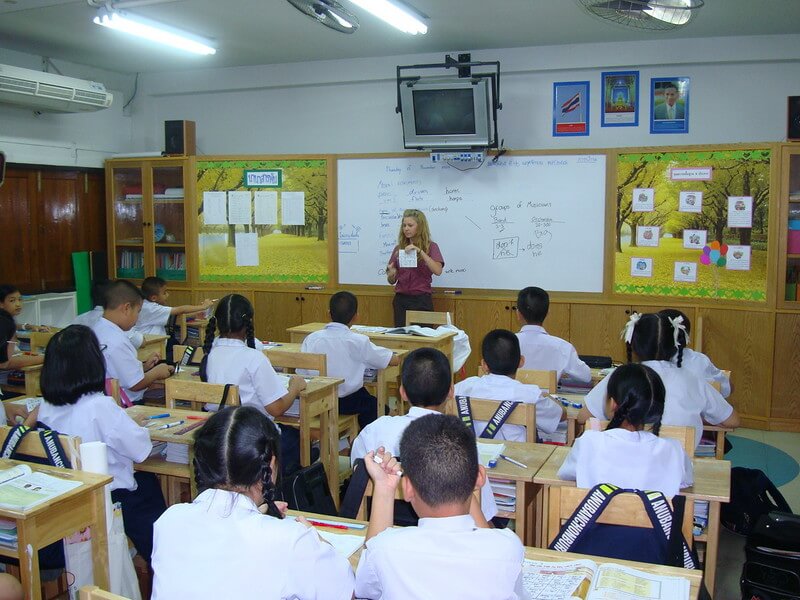“Uh oh,” you think, glancing at the clock. It’s 11:30, but this lesson isn’t scheduled to end until 11:40! Your lesson plan is fully finished, the students are sitting anxiously waiting for the next ESL game or activity. You don’t want to repeat last week’s class with these students; somebody nearly lost an eye during a game you invented on the spot (as it turns out, “Catch the Teacher” isn’t very safe). What to do?
Most teachers run into this situation from time to time. Although we put effort into our TEFL Lesson plans and make good choices about how to best schedule the activities, each class is different. You will run into a class that is faster at finishing their work, or find that free cola was distributed at lunchtime (and the hopped-up students are quicker than they usually tend to be). One skill that many teachers develop over time is the ability to adjust their lessons on the fly.
Here’s a live example (from one of Bridge’s Micro-credential courses) of a type of quick game you might incorporate into the last few minutes of classtime:
It really pays to have a few quick, rigorous, no-prep ESL activities in your proverbial back pocket, especially ones that work well when teaching young learners. When you need them, these activities can save you from the last ten minutes of class becoming “dead time.”
If you’re new to teaching, you’ll want to get initial training and qualification with a TEFL certificate. You can explore our online TEFL courses to get started!
1. Pictionary
A classic, yes. It’s a classic because it’s so effective. The quickest is to simply start drawing a picture on the board of a target vocabulary item. You can tell the learners that you want them to guess, or you can reduce your Teacher Talking Time and simply continue until they figure it out. Whoever guesses correctly first gets to try the next vocabulary word.
This game is easily adapted into a team game, too. Give a marker or chalk to a representative of each team. Secretly show them a picture of a target vocabulary word and their teams race to guess what it is. You can make it harder and more academic by telling the guesser to correctly write the word.
2. “Blackjack”
Carry a deck of regular playing cards in your bag and go through all the numbers and face card values. Write 21 on the board and circle it. Draw an arrow up and an arrow down. Tell the students, “You want 21, but you can’t go over it.” Deal everyone in (or each team in for large classes).
They can say Yes or No for whether they want another card. The rule is that they must say the number within three seconds to keep the cards. This forces students to remember English numbers and think fast.
3. Is it real? (Vocabulary Review)
Pull your lesson plan out and look at the target language. Write the vocabulary on the board and also a few plausible, but nonsense, additions.
Example: bear, cat, dog, peay, bat, chio, nad, hen, poq, rat
Give a marker or chalk to the students, or a different color to each team. They have 3-4 minutes to circle the words they think are actual English words.
Read Juliana’s story for ideas on how to get creative with ESL activities for young learners (spoiler alert: prep required!)
4. Shark Tank
Quickly draw stairs on the board, going downward. Shout, “AHHHHHHHHHHHHHHH, a monster!” and draw a shark, dragon, or otherwise terrifying thing on the board at the bottom of the stairs (Pro Tip: all young learners will laugh hard if you label this monster as yourself!).
This game is basically Hangman. Each student or each team guesses letters to try to guess a hidden target vocabulary word. Each time they miss, they move down one step toward the monster.
5. Tic Tac Verbs
Make a Tic-Tac-Toe board. Write subjects on the game (I, you, he, they, the students, etc.). Write “Verb: to _________” at the top. Two teams play Tic-Tac-Toe by saying the subject and the correct conjugation (i.e. “I see,” “He sees”). If they say it correctly, they can mark the board.
This can be used for any verb tense in English, up to present perfect tense and conditionals, so it’s appropriate for all levels.
6. SitStand
Get a bell to keep in your teacher’s bag so that you can always pull this game out. Alternatively, just say “ding-ding!” Write 5-10 vocabulary words on the board and give 1 minute for the students to practice pronouncing them. Then everyone stands up and can’t sit down until they say one of the words correctly. Circle the word on the board but DON’T say it. Point to random students and listen to what they say. If the pronunciation is okay, they get a “ding-ding!” and can sit down. First team with everyone sitting wins, or the last person who sits has to do a forfeit (write a sentence using the word).

7. SeatSwitch
This game assumes that your students can be trusted to be safe. Hold up a flashcard or put one on the interactive whiteboard. Say the word, and the learners repeat. Then do another. Do this until you’ve said all the words in the lesson, and then make a “mistake” with one of the flashcards. This is the cue for the seat switch. It helps clue the students in if you make it a question.
Example: “bird, frog, cat, bear?”
Gesture for everyone to stand up. They have to switch their seat for a different one by the time you count down from ten. Run this a few times to practice, and then increase the speed as is safe for your class.

Check out these easy, no-prep ESL Icebreakers to get your class going on day one or throughout the term.
8. Countdown
This is an adapted game from British television. First, put nine random letters on the board (make sure you have a mix of vowels and consonants). Explain that they have to make the LONGEST word that they can. Set a timer for 30 seconds (or use an actual Countdown Clock, like this one). Demonstrate with a practice round together, working to make a long word. Emphasize that absolutely any word gets points. The only way to get zero points is to not even say, “I” or “a” or “in,” according to which letters are being used.
Example: EASORIYPE
easier = six points I = one point ripe = four points etc.
Split the class into 2-4 teams and repeat the procedure.
9. Telephone Race
Split the class into 2-4 teams and have them line up (BOOM, that’s already five minutes of the dead time solved! Trust me, this will take forever). Secretly say a target word or sentence to the first person from each line. They have to run over to the line and whisper to the next person, who whispers to the person after them, etc. The fastest team to “race” down the line with whispers and then say the target wins!
10. Emergency Line-Up Game
What if you only have a couple of minutes of class left? Imagine you did everything – you cleaned up with the cleanup song, you stacked the chairs, and you lined up in miraculously quick time. Your TA is looking at you expectantly, but you only have two minutes left in class and breaking formation is likely to cause chaos. What to do?
Break out the flashcards. Hold one up. The learners raise their hands to answer. Whoever answers correctly can move to the front of the line. To make this more rigorous, demand complete sentences for the answers.

Now you know 10 of the best no-prep ESL activities for the last ten minutes of class. The best defense, they say, is a good offense. In teaching, the best adjustment for timing is an early adjustment. If you keep your eye on the clock and notice a specific activity is flying by, insert one of these no-prep activities into the lesson right then. Once your students are used to them, these activities can go very quickly and wring more quality English practice out of every spare minute of the class.






